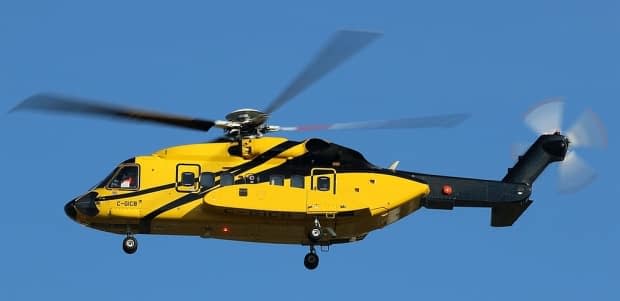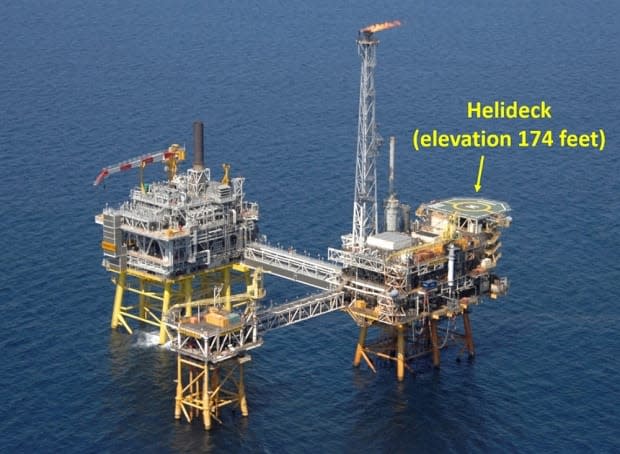Lawsuit filed by passengers on helicopter that came within 4 metres of crashing into ocean

A New Glasgow, N.S., law firm has launched a class-action lawsuit after a helicopter went into freefall — twice — and came so close to crashing that a rotor blade struck the ocean when attempting to transport workers to an oil rig near Sable Island two years ago.
The class action, filed by MacGillivray Law, alleges Canadian Helicopters Limited, the company operating the Sikorsky S-92A, was negligent.
The suit claims damages for the suffering of the 11 passengers and their psychological injuries, including PTSD, as well as damages for loss of earning capacity and medical care and legal costs.
The early part of the flight that departed Halifax Stanfield International Airport just before noon on July 24, 2019, was uneventful, even though visibility was poor that day due to fog.
The helicopter made two attempts to land at the helideck on the offshore rig, but both were aborted because the captain and first officer couldn't see the deck, rig or horizon.
It was on the third landing attempt, after the crew spotted the helideck — but still could not see the horizon or the water — that things went awry.
As the helicopter approached the landing platform, the nose of the aircraft was too high, the helicopter was banking to the right, was approaching at a slower speed than standard and was in an increasingly rapid descent. But the crew didn't notice these hazards because one of them had disengaged the autopilot features that would have alerted them.
Vortex ring state
Although one of the crew eventually checked the dashboard and saw that the nose was too high, they still didn't notice the rapid descent or the slow speed of travel — conditions that are perfect for a helicopter entering what's called a vortex ring state. That is when the air patterns around a helicopter change and the rotor can't keep the aircraft aloft and it begins to drop uncontrollably.
That's what happened.
"The helicopter was in an out-of-control tailspin dropping toward the ocean surface," the court document says. "This was all readily apparent to the class members, who were terrified and bracing themselves for a crash into the ocean surface."
At one point, the helicopter, which was by then dropping at a rate of nine metres per second, came very close to crashing into the offshore rig.

Now 30 metres above the water, the monitoring pilot put his hands and feet on the controls to brace himself and try to help the flying pilot level the aircraft before the expected impact with the ocean.
Now 20 metres above the water, the passengers "felt the helicopter shake and yaw severely to the right," and "the screens and systems all went blank and alarms engaged."
"At the point of near impact, the engines were throttled beyond limit, extremely loud, torqued at well over capacity," the statement of claim reads. "The class members could hear the engines screaming as ocean water sprayed all over the windows.… The class members thought the helicopter was crashing into the ocean surface at high speed and that they were going to die."
Robert Kenney, the representative plaintiff in the legal action, said: "If you can imagine your life passing before your eyes, everything was going crazy. Everybody on the chopper, there was a lot of screaming and hollering."
Another passenger, Donald Shupe, said the drop to the water felt like it happened in seconds.
"We went sideways and I smashed my head on the window and next thing you know I was looking at water," he said. "I looked at everybody else and I said, 'This must be our day.' … I was vibrating inside because I didn't think we were actually going to pull out of this. I honestly thought this was it."
Last-second reprieve
All of a sudden, according to the statement of claim, "in the last small fraction of a second," because of the extremely high torque and the aircraft being banked so far to the right, the helicopter came out of the vortex ring state.
"The helicopter stopped its drop at most just a couple of feet above the ocean surface as the landing gear and bottom made actual contact," the court document says. "The class members observed the end of the main propeller blade strike the ocean surface."
The pilot then flew the helicopter, which was still in a tailspin, straight up to an altitude of about 411 metres as the crew continued to try to stabilize it.
Then, the aircraft began falling again, out of control, and flew over Sable Island in this way until the pilot was able to regain control.
Passengers traumatized
The return trip to Halifax was "rough and noisy," says the statement of claim.
"The class members were already in a state of extreme mental and physiological stress. The class members remained in a heightened state of arousal the entire flight back given the manner in which the helicopter was flying, noisily and jarringly, at a low altitude, with systems down and on autopilot."
Kenney said he's been diagnosed with PTSD because of the incident, and he's not able to concentrate as well as he could in the past.
"Seems like I'm always lost in space," said Kenney, who lives in Sheet Harbour, N.S. "I used to always be like a trivia champion … and now as soon as somebody asks me a question, point blank, my mind is gone."

Although Kenney did go offshore on two occasions since then, he recently turned down a job offer in the industry because he is too anxious about flying. He said he now has to work many more hours at his job on land to make up for the wages he's lost, which has affected his lifestyle and family.
Shupe, of Triton, N.L., said he went back to work about a year after the incident, but was then laid off.
He also said he lives with the memories of that day, and has nightmares about helicopter crashes.
"I am not the same person today as I was two years ago. And I know if I don't have professional help, God forbid I don't know what's going to happen."
Transportation Safety Board report
The lawsuit alleges the company allowed recordings of conversations between the two pilots to be destroyed before they could be heard by investigators.
An investigation by the Transport Safety Board of Canada found that the helicopter, which was removed from service after the incident, stopped just four metres above the water.
The report also found that the company's operating procedures did not give flight crew enough guidance to ensure that their landing approaches were within industry-recommended standards, and did not warn of the hazards of overriding autopilot in poor visibility.
MORE TOP STORIES

